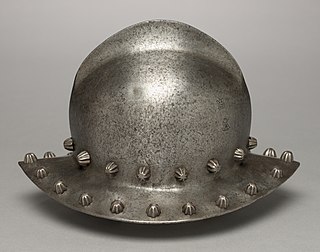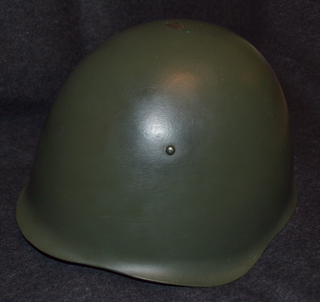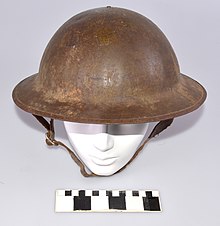
A hard hat is a type of helmet predominantly used in workplace environments such as industrial or construction sites to protect the head from injury due to falling objects, impact with other objects, debris, rain, and electric shock. Suspension bands inside the helmet spread the helmet's weight and the force of any impact over the top of the head. A suspension also provides space of approximately 30 mm between the helmet's shell and the wearer's head, so that if an object strikes the shell, the impact is less likely to be transmitted directly to the skull. Some helmet shells have a mid-line reinforcement ridge to improve impact resistance. The rock climbing helmet fulfills a very similar role in a different context and has a very similar design.

The Stahlhelm is a German military steel combat helmet intended to provide protection against shrapnels and fragments or shards of grenades. The term Stahlhelm refers both to a generic steel helmet and more specifically to the distinctive German military design.

The M1 helmet is a combat helmet that was used by the U.S. military from World War II until 1985, when it was succeeded by the PASGT helmet. The M1 helmet has become an icon of the US military, with its design inspiring other militaries around the world.

The Adrian helmet was an influential design of combat helmet originally produced for the French Army during World War I. Its original version, the M15, was the first standard helmet of the French Army and was designed when millions of French troops were engaged in trench warfare, and head wounds from the falling shrapnel generated by indirect fire became a frequent cause of battlefield casualties. Introduced in 1915, it was the first modern steel helmet and it served as the basic helmet of many armies well into the 1930s. Initially issued to infantry soldiers, in modified form they were also issued to cavalry and tank crews. A subsequent version, the M26, was used during World War II.

A kettle hat, also known as a war hat, is a type of helmet made of iron or steel in the shape of a brimmed hat. There are many design variations. The only common element is a wide brim that afforded extra protection to the wearer. It gained its common English language name from its resemblance to a metal cooking pot. The kettle hat was common all over Medieval Europe. It was called Eisenhut in German and chapel de fer in French.

The M1917 Revolvers were six-shot, .45 ACP, large frame double action revolvers adopted by the United States Military in 1917, to supplement the standard M1911 pistol during World War I. There were two variations of the M1917, one made by Colt and the other by Smith & Wesson. They used moon-clips to hold the cartridges in position, facilitate reloading, and to aid in extraction since revolvers had been designed to eject rimmed cartridges and .45 ACP rounds were rimless for use with the magazine-fed M1911. After World War I, they gained a strong following among civilian shooters. A commercial rimmed cartridge, the .45 Auto Rim, was also developed, so M1917 revolvers could eject cartridge cases without using moon-clips.

The Mk III Helmet is a steel military combat helmet that was first developed for the British Army in 1941 by the Medical Research Council. They were issued to troops in April 1944 and then worn in combat for the first time by British and Canadian troops on D-Day. Mk III and Mk IV helmets were used alongside the Brodie helmet for the remainder of the Second World War. It is sometimes referred to as the "turtle" helmet by collectors, because of its vague resemblance to a turtle shell, as well as the 1944 pattern helmet.

The M1C helmet was a variant of the U.S. Army's popular and iconic M1 helmet. Developed in World War II to replace the earlier M2 helmet, it was not made available until issued to paratroopers in January 1945. It was different from the M2 in various ways, most importantly its bails. The M2 had fixed, spot welded "D" bales so named for their shape, similar to early M1s. It was found that when sat on or dropped, these bails would snap off. The solution was the implementation of the swivel bail, which could move around and so was less susceptible to breaking.

The Zuckerman helmet, officially designated the Civilian Protective Helmet, was a British helmet designed for use by civil defence organisations and the general public during World War II. It was researched and designed by Solly Zuckerman, Derman Christopherson and Hugh Cairns.

The M/1923 helmet was a combat helmet issued to Danish troops during the interwar period and saw service in the Second World War. It was the first helmet to be issued to the Royal Danish Army and Navy. The helmet was produced by the Danish company A/S Glud & Marstrands Fabrikker.

The Helmet Steel Airborne Troops (HSAT) is a paratrooper helmet of British origin worn by paratroopers and members of airlanding units. It was introduced in the Second World War by the British Army and was also used by other Commonwealth armies. It continued to be used in the postwar era until the early 1980s. It was in the process of being replaced, with parachute battalions being issued as priority, when the Falklands War occurred. As with the similarly shaped RAC helmet and despatch rider motorcycle helmet, it was initially manufactured by Briggs Motor Bodies at Dagenham.
The M76 Paratrooper helmet is a combat helmet of British origin issued to paratroopers and airborne forces of the British Army.

The M1940 helmet was the primary combat helmet used by the Armed Forces of Portugal, from the 1940s to the late 1960s. The M1940-63 and the M1940-63 Paratrooper are improved versions of the M1940 helmet that were introduced in the 1960s and are still in limited use. Besides being used by the Armed Forces, the M1940 and the M1940-63 helmets were also used by the Portuguese Security Forces, including the Public Security Police and the National Republican Guard (GNR). This helmet was largely replaced by the PASGT in the early 1990s.
The M33 Helmet is a steel combat helmet designed in the 1930s in Italy, and was the standard combat helmet of the Regio Esercito up to World War II, and of the Esercito Italiano well into the Cold War.

The m/37 helmet is a military steel combat helmet used by Swedish armed forces. Replacing the m/21 helmet, the m/37 would be modernized in 1965 with an updated liner and see use into the 1990s with its replacement by the M1990 Kevlar helmet. Three main variants existed. The first had a three pad liner system, like the m/21 and m/26 before it. The third, most common versions of the modified helmets had the same liner as the pictures but with a canvas chinstrap with a quick-release system. The helmet could be gray, as it always was during the second world war, or painted green as it often, but not always, was during the cold war.

The M32 helmet also known as M32/34 is a military steel combat helmet used by Czechoslovakia from its adoption in 1932 to its annexation by Nazi Germany in 1939. The helmet also being used by the Slovak Republic and Finland among other countries that the helmet would be worn by.

The Wz50 also known as M50 is a steel combat helmet used by Poland from its introduction in 1950 to its replacement by the Hełm wz. 67 in 1967. The helmet would be widely exported to a number of Arab countries for its low price. Early pre-production helmets by a double riveted chinstrap and cow skin leather liner. All models of helmet would include an maker and manufacture stamp

The M34 is a steel combat helmet used by the Netherlands from its introduction in 1934 replacing the previous M23/27, to the invasion by Nazi Germany in 1940. From which it was replaced by the M53 helmet, a local copy of the American M1 helmet. A tropical variant of this helmet was produced for use by the Dutch East India Army in present-day Indonesia known as the KNIL model.

The Ssh-36 was a steel combat helmet developed and used by the Red Army. It was designed by Aleksandr A. Shvartz with production started in 1936. Its large front rim and wide flares over the ears provided good protection for the wearer. The German M35, introduced a year before the Russian SSh-36, served as a model for the development of the SSh-36.
The SSh-39 and SSh-40 were two similar designs of steel combat helmet designed and used by the Soviet Union's Red Army. They were the main forms of helmet in use during World War II and had only superficial differences.


























